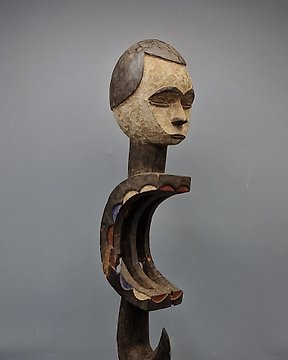
Harvinainen JA VAIKUTTAVAN EKPO CREST - EKET - Nigeria (Ei pohjahintaa)
Nro. 83440423

Nro. 83440423

An Epa ceremonial mask, Nigeria, called "the mask of Osun” has three levels. The first is the face, which is surrounded triangular protections, the face itself has a reddish tinge and is ornamented with black and white spots, the eyes are big and round, the nose wide and flat and the mouth is pouted and round; below the eyes are two rectangular holes that give the wearer visibility. Atop the head of the mask is the second level with three female figures kneeling on a platform with zigzag ornamentation; all with beaded necklaces and skirts. The two in the middle rest their hands on their breast while the one in the middle is resting her entertained hands on her lap; All with a reddish tinge and all but the one in the left face painted black; the top level of the mask is held up by their hair which is coiffed identically. The top level of the mask has a carving of the goddess Osun kneeling in the middle with her arms outstretched and holding a white tentacular figure on her right by its neck and a kneeling woman with waist beads and a skirt on her left. The female figure on the left of sun has similar coiffure to the goddess with a band around it similar to a crown. and is resting her hands on her breast. The goddess sun, with a blue tinge has conical breasts, a protruding navel and beaded necklace. Her face is serene with large round eyes, wide nose and full lips. Signs of use. This type of mask is unique to the Ekiti subgroup, appearing during the Ijeshu festival to honor the god and ancestor of the town of Osi-Ilorin. Certificate of origin and provenance.
“An Epa mask is a ceremonial mask worn by the Yoruba people of Nigeria during the Epa masquerade. Carvings representing priests, hunters, farmers, kings, and mothers are usually depicted on the masks. They are used to acknowledge important roles within the community, and to honor those who perform the roles, as well as ancestors who performed those roles in the past.When not being used during performances, Epa masks are kept in shrines where they are the focus of prayers and offerings from community elders.”
Source: University of Birmingham.
Näin ostat Catawikistä
1. Löydä jotain erityistä
2. Tee korkein tarjous
3. Maksa turvallisesti